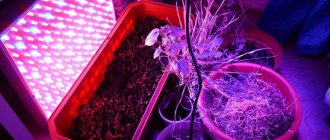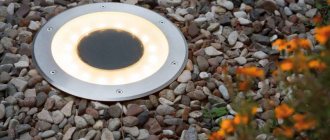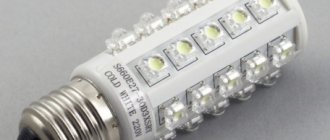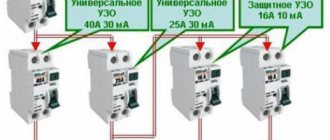It is difficult to imagine a modern home without well-equipped artificial lighting. The comfortable time spent in the room, the possible functionality of target zones, work area, etc. directly depend on it. Due to the spread of modern technologies, LED bulbs are increasingly used to decorate the lighting in the room. That is why many ordinary people are wondering how to organize LED lighting in an apartment and how it stands out from other types of lighting devices.
What is LED lighting
Diode lighting is a method of supplying artificial light using energy-saving LED lamps. The technology has become widespread relatively recently, but has already earned recognition from interior designers.
With the help of LED devices it is easy to implement any lighting scenarios. The devices look attractive in the interior and are perfectly combined with the smart home system.
You can insert LED lamps into conventional lighting fixtures or immediately purchase LED devices. However, before choosing products, it is important to understand how they function.
Example of LED lighting in an apartment
LED lighting in the interior - photo
NeoclassicalLED lighting in the interior is a very convenient and effective tool for creating an exclusive atmosphere in any room.
0 0 votes
Article rating
Design and principle of operation of LEDs
LEDs are devices created on the basis of semiconductor elements with an electron-hole junction. Devices emit light only when electric current passes through them.
One of the semiconductors is dominated by positive ions, the other by electrons. When a current passes through the point of their contact, recombination of elements occurs. As a result, excess energy appears, which is converted into light radiation.
Diodes emit rays in the green, blue and red spectrum. As a result of mixing these tones, a white glow is obtained. Depending on the type of lamp, the flows can be either warm or cold.
Standard LED lamp design:
- A board with diodes located on it.
- Radiator.
- Driver.
- Diffuser.
- Base.
- Flask of any shape.
- Lower and upper holders.
The most important element of the system is the driver, which is located in the base of the device. It is a combination of a transformer, capacitors and microcircuits. The cost of LED lighting sources depends on the quality of this part. The driver is used to convert alternating current into direct current and stabilize the incoming voltage. Another function is powering the LEDs.
The socket is a necessary element for connecting the lamp to the lamp socket. There are several types of parts, but the most common are pin and screw.
The radiator serves to remove heat from the LED crystals. The larger the part, the better the effect of its work.
The diffuser plays an important role in the system. It helps to evenly distribute light fluxes and protects the lamp body from moisture and dust.
Colored LEDs
Round LED lamp
LED chandelier with remote control in room design
If in appearance it still resembles an ordinary lamp with traditional incandescent lamps, then its internal design is distinguished by a complex electronic filling, consisting of:
- built-in radio receiver and controller;
- remote transmitter installed in the control panel.
The remote control allows you to remotely turn on or off the light, and adjust the degree of room illumination at a distance from the switch.
Manufacturers specially encrypt radio remote control signals from the remote control transmitter to the chandelier receiver with different codes. This makes it possible to exclude accidental switching on of lighting devices by extraneous commands coming from neighbors in multi-story buildings.
However, there are also inconveniences to this. I came across them when repairs were needed.
The fact is that an LED chandelier with a butterfly-shaped remote control, shown in the topmost picture, was purchased for the grandchildren’s children’s room. The eldest boy did not go to school yet, but he really liked to show his little sister various lighting effects.
She really liked this lighting. Both received a lot of positive emotions. But, after about six months of intensive switching on, the chandelier stopped working from the remote control.
I had to start repairing it, which boiled down to buying and replacing the controller and remote control, which I previously described in a separate article.
Replacing the controller took no more than half an hour. The grandchildren were very pleased that it was working again.
An LED chandelier does not heat surrounding objects like incandescent lamps. It is well suited for installation in suspended ceilings.
However, when choosing its design, I recommend paying attention to the design of the room. She must:
- match the color of the interior;
- correspond in size to a safe location at ceiling height;
- meet the purpose of the room (not for the corridor and hallway);
- match the design solutions with its shape and design.
For example, expensive chandeliers with crystal inserts are chosen for lovers of the classics; rectangular or round “tablets” are created for the Art Nouveau style with low ceilings.
The range of color shades that LEDs create is quite extensive. They should be taken into account when creating the interior:
- yellow tones calm and help you relax;
- white improves performance;
- reds stimulate the body, providing a tonic effect;
- green enhances the attention necessary for creative activity;
- blue helps you relax and relieve tension.
LED lamps: pros and cons
To make a decision in favor of LED lighting, it is important to study the merits of light sources. Main advantages:
- Long service life: LED lamps can last up to 50,000 hours.
- Environmental friendliness and safety: no toxic components are used in the manufacture of lamps.
- Economical energy consumption: diode lamps require much less electricity than other lamps, but at the same time provide optimal illumination intensity.
- Housing strength: LED lamps will not break if accidentally dropped from a small height.
- Excellent light output parameters. The average luminous flux power is 50-100 Lm per 1 W.
- Optimal light spectrum: LEDs provide comfortable lighting similar to sunlight. For comparison: the color rendering index of natural streams is 100 units, LED lamps are 80-85.
LED lighting lamps are suitable for any room, including those with high humidity. The devices do not require maintenance or additional protection measures.
Important! The service life of devices does not depend on the frequency of switching off and switching on.
The disadvantages of LED lamps are much more difficult to identify. You can name one - relatively high cost. However, the disadvantage is compensated by reduced electricity consumption.
LED lamps in the interior of the apartment
Basic points
Great interest in LED lamps has arisen due to their good performance characteristics - they can produce a fairly wide range of color spectrum from cold to warm. In addition, the variety of shapes and designs of LED lighting devices makes it possible to choose the right model for almost any interior style. Fixing methods provide relatively simple installation on a ceiling surface, furniture, etc., in addition to this, it is worth considering other advantages and disadvantages.
Advantages and disadvantages of LED lighting
The advantages of LED lighting include:
- High performance - the efficiency of LED devices for an apartment is about 90 - 95%, which is disproportionately higher than that of other types of lamps;
- Service life – has the longest service life before failure;
- It is not afraid of mechanical damage - if the bulb or body is damaged, it does not lose its functionality and will continue to shine even with the cap removed;
- It has a stable and high-quality luminous flux - it has a more beneficial effect on the organs of vision and does not cause fatigue;
- Very low heat generation during operation - does not cause heating of surrounding objects, significantly lower degree of fire hazard.
- Does not contain mercury, unlike fluorescent lamps.
LED lighting has one significant drawback - the high cost of the devices. Of course, you can find more budget options on the market, but the quality of such lamps leaves much to be desired.
Types of LED lighting for apartments
In addition to the basic dimensional and physical data, LED apartment lighting can be used to solve various problems, which determine the type, purpose and location of the lamps.
By type, LED lighting is divided into the following categories:
- The main one is designed to ensure sufficient visibility over the entire area, located in the center of the room or in a specific area if the work area needs to be illuminated.
- Diffused lighting - sets the light background in the room, does not require a lot of power, the main thing is to ensure comfort while relaxing or engaging in any activity.
- Decorative lighting - LED lighting for decorating details in interior design, practically does not provide enough light for visibility, but allows you to create interesting effects, sometimes used as a night light.
- Accent lighting is designed to draw attention to a specific object; this is the illumination of furniture, paintings, floor contours, and ceilings. Such contour lighting provides virtually no light and does not improve visibility in any way.
Types of lamps and their service life
Which LED lighting option should you use to replace your old incandescent light bulb? Today this is not the only option, so let’s take a closer look at how LED lighting can be implemented in an apartment:
- According to the shape of the lamp - there are pear-shaped, candle-shaped, flat, truncated, mushroom-shaped and other options.
- by the presence of a cooling radiator;
- according to the spectrum of the emitted light flux - they come with a warm glow, cold, neutral and other shades;
- by type of base - the most common bases in everyday life are E and G, which in turn are also divided by diameter or distance between contacts;
- by type of diodes and installation location - some options are intended only for indoor lighting, others for outdoor lighting (LED spotlights, floor lamps, etc.)
Based on their service life, lighting devices with LEDs of medium and high quality are distinguished. The first option, as a rule, is designed for 50 thousand hours of operation, the second, for 100 thousand hours. There are also low-quality LEDs, but the lifespan of lamps based on them cannot be predicted due to the large scatter, which is quite difficult to influence. In practice, the service life largely depends on the quality of electrical energy - due to voltage surges and deviations from nominal modes, LED lighting devices fail much more often.
Application of LEDs: types of lighting
Due to their excellent performance parameters, LED lamps are suitable for use indoors and outdoors. Types of lighting:
- Apartment.
- Office.
- Trade.
- Industrial.
- Street.
- Spotlight.
- Emergency.
LED lighting is especially often installed in living rooms. Diode lamps can be present in any lamps: wall, ceiling, decorative. You can also use LED strips. They are good for illuminating interior items, furniture, multi-level ceilings, niches, and stairs.
Apartment lighting with LED lamps
Edge LED
LED blocks must be technically correct and accurately placed.
“Edge” is translated from English as “corner”. This is where the peculiarity of this type of backlight comes from - the LEDs are located along the edges of the inside of the screen (on the right or left side). The technology is affordable, which has made it popular.
The strip on which the LEDs are placed is attached to the side surfaces of the matte diffuser, so the light background is more uniform.
Thanks to the end arrangement of the diodes, it was possible to reduce the thickness of the TV body. At the same time, eye strain is further reduced.
But, LED blocks must be technically correct and accurately placed. If you make a mistake, flares will appear on the screen - light spots that appear as a result of uneven glow.
What Edge LED is on a TV is clear, but what are the advantages of this technology:
- the matrix has become more compact. The side placement of the LEDs made it possible to reduce the overall thickness of the panel;
- high brightness, which ensures comfortable reading of information from the screen.
There are also disadvantages:
- glare may appear. In new TVs, in order to distribute reflected light more evenly over the surface of the matrix, they make a reflective surface with a matte finish. But this solution increases the price of TV;
- Compared to Direct LED, Edge LED consumes more electrical energy.
With edge lighting, the picture in the center of the display will appear darker. In the manufacture of many TV models, local dimming tape is used, which reduces brightness differences.
Emission color of LED lamps
LED lamps can have different shades of light. To determine the parameters, there is a color range, the main indicators of which are indicated in the table.
Color temperature indicators
| Warm white | Natural white | Cold white |
| 2700-3000 K | 4000-4500K | 6000-6500 K |
The higher the color temperature, the brighter the light from the lamp. A cold glow with a blue tint may not seem very comfortable for lighting an apartment. Therefore, natural white is ideal for home lamps.
Advice! To illuminate the bedroom, you can choose warm glow lamps.
Shades of LED lamps
LED characteristics
Operating current (mA, milliamps)
LED elements operate from 10-100 mA or more. The more powerful the diode, the higher the current it requires, but the greater the likelihood of the LED burning out. Drivers are used to rectify the current characteristics. The more accurately they work, the longer the diode will last.
Voltage (V, volts)
Depends on the semiconductors and other chemical elements used in the manufacture of the LED element. Their qualitative and quantitative characteristics directly affect the color of the glow.
Power (W, watts)
Determined by current and voltage. The higher the power, the hotter the LED gets, but the faster it fails. To prevent such developments, they are forcibly cooled by installing radiators made of aluminum or other materials with similar characteristics.
Color temperature (K, Kelvin)
It depends on the materials used to make the diode. Temperature determines the hue of the LED. It can be warm yellow (1,800 – 3,500 K), neutral white (3,600 – 5,000 K) or bluish-cold (5,100 K and above).
Luminous flux (lx, lux)
Determines the light intensity. It means the number of lumens (units of luminous flux) per unit of power equal to 1 W.
Scattering Angle (°, degree)
It depends on the characteristics of the diverging lens. For a single diode, the dispersion angle ranges from 50 to 120°. If accent (spot) lighting is required, use a collective lens. If the dispersion angle needs to be increased to 270-360°, modular structures are made.
LED lamp life
Depending on the type of lamp and manufacturer, the product life is from 20,000 to 50,000 hours of operation. That is, a high-quality lighting source can last more than 5 years if used daily.
Usually information about the service life is indicated on the packaging, but you can’t always believe what they write. For example, manufacturers often indicate an impressive service life, although the products are cheap. It is unlikely that an inexpensive light bulb will last as long as possible.
Even if the manufacturer did not cheat with the resource, it is worth considering external factors that may affect the service life. These are: power surges, power surges, poor-quality electrical wiring, damage to the lamp. If LED sources are located outdoors, their operation is negatively affected by adverse weather conditions. Undesirable factors can reduce the lamp life by about a third.
It is impossible to predict in advance how long a particular lamp will last. However, there are ways to extend the life of diode light sources:
- Using a dimmer. A device with a switch lever is used to adjust the brightness of the light. The dimmer suppresses inrush current, which is often the main cause of premature lamp burnout.
- Organize “smart lighting”. Automatic switching on and off of lamps upon command or sensor signal will avoid unnecessary manipulations.
- Buy a quality lamp. A well-designed device is an important factor for the correct operation of the lamp.
If LED strips are used for illumination, it is better to stick them on aluminum surfaces. The material absorbs part of the thermal energy, so the lighting device will not fail as a result of overheating.
Nuances of lighting depending on the room
As you saw earlier, LED lighting in an apartment can be provided by a wide variety of devices - lamps, strips, spotlights, etc. Due to the wide variety, both in terms of design and technical parameters, the choice of a specific option is made in accordance with the room for which it will be used. This will allow you to adapt the light radiation to specific tasks, select the brightness level and direction of the light flux.
Living room
LED lighting in the living room
The living room or hall is the largest and most spacious room where the whole family gathers in the evenings, guests, relatives, etc. are received.
In this regard, it is important for the living room to divide LED lighting into zones and functionality:
- General - sets the general background in the room, in most cases it is set by a large chandelier, which is the central decoration of the room. In addition, the main lighting can be provided by spotlights distributed on the ceiling or concentrated according to some lighting scheme.
- Working or zonal - designed to concentrate the light flux in a specific area (near the reading chair, above the desk, at the coffee table, etc.).
- Decorative lighting - used to decorate the living room, most often located around the perimeter of the ceiling, but can also be used to illuminate niches, furniture, etc.
Bedroom
LED lighting in the bedroom
For the rest room, you do not need to select too powerful LED lighting devices, otherwise they will interfere; it is better to turn on dim lights before going to bed. Therefore, a low-power chandelier of small dimensions is selected, but if necessary, wall sconces or table lamps mounted on a cabinet can be installed near the bed. The area near the bed can be decorated with contour lighting from the same LED strip or separately installed lamps.
Children's
LED lighting in a nursery can be organized based on the child’s age, gender and preferences. Using RGB tape, you can organize controlled local lights that will change color at your discretion.
The space in the nursery can also be divided into zones that will be correctly illuminated in different ways:
- A playroom is a place for storing and using toys; it does not require too much light. The lighting here can be diffused and dim. To decorate and obtain additional light, you can use LED strips, which are additionally bent into any convenient shape.
- A desk - a place for doing homework, writing, drawing or reading - definitely requires LED lighting with a directed powerful flow. This is best achieved by a table lamp with an adjustable reflector.
- Sleeping place - it is better to equip the bed or bedside table with a night light with a switch next to the bed. This is a convenient way to maintain a subdued atmosphere until bedtime.
Kitchen
LED lighting in the kitchen
Depending on the size, the kitchen is also divided into several zones; in the case of small areas, you can get by with general lighting, but for rooms of medium and large areas it is advisable to make a division.
LED lighting in the kitchen can be divided into three categories:
- General – necessary for visibility and normal orientation in the surrounding space. Can be organized using an LED chandelier or ceiling lights. As a rule, it is located either in close proximity to or above the eating area. If there is a window in close proximity, it should blend well with natural light.
- Illumination of an apron or work area - placed under the upper cabinets above the countertop. Designed to simplify the work of cooking, washing dishes and other kitchen chores. It is displayed with a clear orientation to the workspace and must have sufficient brightness of the LEDs.
- Decorative - used to decorate furniture in the kitchen, less often, as LED lighting for ceiling structures.
Hallway
LED lighting in the hallway
Most often, no long-term activities are carried out in this room; after entering the apartment, you or your guests leave shoes and outerwear here. Rare transitions from room to room only briefly lead to the hallway. Therefore, there are no complex requirements here; you can get by with one chandelier or a pair of pendant lamps. Wireless LED lighting devices work well.
Separately, you can highlight the lighting of the mirror, if there is one in the hallway. When arranging this type of lighting, it is important to direct the flow so that the light does not blind the eyes.
Bathroom
LED lighting in the bathroom
In the bathroom, it is important to illuminate the most popular places - the shower area and washbasin. It is important for them to install conventional lamps with powerful white LEDs. The housing of bathroom fixtures must be grounded for your own safety, and if for technical reasons this is not possible, you should connect them via a low-voltage power supply or through an RCD.
In addition, you can make decorative LED lighting around the perimeter of the bathtub, furniture, mirrors, etc. It is important that all lighting equipment has a sufficient dust and moisture resistance class, for example, the maximum of the range is IP68. Such models can normally withstand even temporary immersion under water.
How LED light sources differ from others
We have already discussed the characteristics and benefits of LED light bulbs. Let's move on to comparing these light sources with others. Let's look at the differences from fluorescent, halogen and incandescent lamps.
Halogen lamps
The main disadvantage of such lamps is strong heating. The temperature inside the flask rises due to circulating gases. This does not happen with diode sources, because the main difference is the operating principle.
Halogen lamps can operate for up to 4,000 hours. This means that their service life is almost 10 times less than that of LED devices.
Halogen lamp for spotlight
Fluorescent lamps
The main element of a luminescent device is a tube with a phosphor. Over time, the material fades and the lamp becomes unusable. It is worth noting that it has a fairly long service life. However, the maximum operating time of the device is 20,000 hours. That is, 2.5 times less than that of LED devices.
Another argument against fluorescent devices is that over time they change color and lose brightness. This occurs precisely as a result of burnout of the phosphor.
Fluorescent lamp for lamp
Incandescent lamps
The main difference between incandescent lamps and LED products is the light element. In these devices, it is a metal spiral, which, when heated, begins to emit streams. Such products become unusable after approximately 1,000 hours of operation. However, their use is generally abandoned due to high energy consumption.
Incandescent lamp for lamps
Fairy tale
In one far, far northern Country there lived a Worker. Let's call him... well, let's say I-wan.
I-wan had a family that he loved, Work, which brought him his Piece of Bread, and a House where I-wan came to rest after Work.
The Ilyich Light Bulb, which the Communists had once given to Ivan, shone in the House. I-van looked at the Light Bulb with bewilderment, rubbed it on his shirt on his belly and screwed it into a socket under the ceiling, after which he conveniently forgot about the light source.
The world's oldest incandescent light bulb has been burning continuously since 1901.
I-wan lived, in general, quite happily. But Happiness, as usual among People, did not last too long.
One day the Communists left. It happens.
Yi-wan was happy at first. He was really tired of listening to the anthem every morning. And then I thought about it.
The house where the Communists met in their Council was quickly demolished, and in its place a chair was put in which the green Toad immediately sat down.
And first of all, I sent out bills to all the People for what the Communists had previously given them.
I-wan looked at the bill for electricity and realized that the happiness was over. And, it seems, for a long time. This happens to People often.
Several years passed, and a neighbor from another Country in the East, an Engineer named Lee, came into I-wan’s house. He showed Yi-wan the LED light bulb that West Country resident Nick had come up with and explained that he only had to pay Toad for it once. And then she herself will pay extra for the fact that your Nick Light is on.
Storyteller's Note: It is believed that the first LED was created by the American Nick Holonyak in the 60s of the last century. However, 30 years before, a glow at the point contact of a diode detector was discovered by Russian radio amateur Oleg Losev. His Happiness was also short-lived - in 1942, Oleg Vladimirovich died in besieged Leningrad.
Oleg Vladimirovich Losev studied the effect of electroluminescence in the late 30s of the 20th century
I-wan routinely wiped the Light Bulb on his shirt on his belly and screwed it into the socket on the ceiling...
LED strip or LED lamp: which is better?
In addition to luminaires with LED lamps, LED strips are used to organize lighting. They are a flexible board with small LEDs placed in series. Such products can emit both multi-colored and monochrome glow.
Varieties of colored glow tapes:
- RGB: A system that combines blue, green and red hues.
- RGBW: a tape where, in addition to the three main shades, there is cool white. Thanks to the additional diode, the color spectrum of the glow expands.
- RGBWW: a tape where, in addition to all the shades listed above, warm white is added.
It is not entirely correct to compare lamps and strips, because the latter perform slightly different tasks. They are not intended for main lighting - only for decorative lighting.
There are still some points for comparison. For example, power, placement nuances, service life. A brief review of LED strips and lamps, based on real experience in using LED lighting, will help you choose your option.
Monochrome LED strip
Colorful temperature
On sale you can find lamps and lamps with a color temperature of 2700, 4000 or 6500 Kelvin. What does this parameter affect?
On the perception of lighting: low temperature corresponds to warm light, high temperature to cold light. Light with a temperature of 2700K is least tiring for the eyes; however, neutral lighting (4000K) provides more accurate color reproduction.
The influence of color temperature on the perception of lighting
How to choose LED lamps: useful tips
If you have already appreciated the benefits of LED lighting, you can move on to choosing light sources. What to pay attention to:
- Color rendering index: it is best to choose models with an index of 80 or more CRI. They provide lighting that is as close to natural as possible.
- Pulsation range: to avoid discomfort, give preference to lamps with flicker levels of no more than 15%.
- Color spectrum: lamps with characteristics of 2700-3000 K are considered optimal for the home.
- Shape: products are available in the form of a flask, tablet, capsule, pear, candle, ball. Flat LED lamps are also popular. The power and flow dispersion angle depend on the shape.
- Base size: It is important to choose a size that will be compatible with your fixture.
Another parameter that you will have to deal with when choosing is whether the flask has a matte or transparent coating. It’s worth deciding in advance what color you need: rich or diffuse and soft. If you vote for the second option, it is better to choose a device with a matte surface.
Advice! You should not purchase devices whose packaging indicates a long service life, but at the same time the warranty is only a year or two. It is unlikely that such devices will be of high quality and will last a long time.
LED lamps in different rooms
The range of modern LED lighting products is very large. Designers, in close collaboration with designers, are developing new product lines intended for use in certain rooms - the hall, the kitchen, the office. Of course, the installation location of the product is given for informational purposes, in no way limiting the wishes of consumers. If the buyer is sure that this model will look amazing in the bedroom, the manufacturers’ recommendations can be safely ignored. The only exceptions are lamps for “wet areas”, such as the bathroom, swimming pool, and the area near the kitchen sink. Such products are subject to increased IP level requirements.
So, which lamps to choose for different rooms, and how to combine them?
Decorative LED lighting: possible options
If you want to add the finishing touches to your interior, don't forget about decorative lighting. It can be organized using various LED devices. We offer 5 interesting ideas.
Ceiling lighting
There are two options for implementing the idea. The first is the installation of miniature built-in lamps. The second is an LED strip located around the perimeter of the ceiling structure, on shaped elements or cornices.
LED ceiling lighting
Floor lighting
Using built-in diode lamps and LED strips, you can decorate baseboards, stair steps, and protrusions on the floor covering. Combinations of different lighting devices are allowed to realize bold ideas.
LED floor lighting
Illumination of mirrors and paintings
You can stick an LED strip around the perimeter of the back surface of a picture or mirror. This way it’s easy to get unobtrusive diffused lighting, which will allow the eye to focus on the decorative items.
A more common option is to use special lamps. Such devices are mounted on the top or bottom of the frame, after which the light flow is adjusted so that it falls at a certain angle. The exact parameters depend on the type of mirror or painting.
LED lighting for pictures
Wall lighting
Lamps that emit downward luminous fluxes look great on the walls. Scattered rays of light will highlight decorative items and original finishes. If the wall is long, three or four devices are enough. For narrow surfaces, two devices are sufficient.
LED wall lighting
Niche lighting
To decorate niches, it is better to use a monochrome LED strip, placing it around the perimeter of the recess. The shade of the glow should be chosen based on the type of general lighting and the basic colors in the interior.
Idea! To decorate rooms, you can use LED garlands, nets, and curtains.
LED wall lighting
Children's
This room is a separate world, created specifically for the comfort of a child. The lighting in it must be of high quality, carefully thought out and meet the tastes and hobbies of the little owner. Fortunately, manufacturers offer a wonderful variety of bright and unusual models, from various animals and natural phenomena to fantasy ones.
The room is necessarily divided into zones - bedroom, playroom, work, so one ceiling lamp, even the most stylish and powerful, is not enough. Help to complement the interior:
- garlands and LED strips mounted around the perimeter of the ceiling and above the bed;
- wall sconces and lightboxes in the form of funny animals, clouds and rainbows, characters from fairy tales and films, graceful plants;
- You can put an original night light in the shape of a snail, dog or soccer ball on the bedside table;
- The desktop must be equipped with a sufficiently bright, comfortable for vision, table lamp with the ability to adjust the tilt and power.
Lamps with built-in players are available, as well as compact models of night lights that plug into an outlet.
It is necessary to ensure the safety of the child by abandoning fragile lamps with many small decorations and oversized items that will interfere with the active baby.
Are LED lamps profitable: let's talk about savings
Using LED lights is considered a great way to save energy. Let's figure out how this happens.
On average, the operating voltage of the LED fluctuates between 2 and 4 V. The power consumption indicator is no more than 1 W. In this case, the light output of the devices is approximately 80 lm/W.
For comparison: incandescent lamps emit only 10 lm/W, and fluorescent devices up to 60 lm/W. At the same time, they consume much more energy.
It turns out that with minimal energy consumption, the luminous flux of LED lamps is much brighter than that of incandescent lamps and fluorescent devices. If you consider that LED devices also last longer, you can make a clear choice in their favor.
Create a schema
Creating a distribution diagram for electrical appliances requires an accurate floor plan. It is needed primarily for the convenience of the electrician - so as not to make a mistake in the exact location of specific lighting devices and related equipment. In the diagram you must indicate (strictly in accordance with the rules of electrical installation work) the location of the following components:
- Every lamp.
- Distribution boxes.
- Switches.
- Wiring (indicating phase, zero, ground).
- Sensors, power supplies and control units (if they are intended).
Important! For maximum information content, you can specify in the diagram the power of the lamps, the cross-sectional area of the wires, the color of the cores and their corresponding phases, the voltage rating before and after the modules.
Alternative to LED lighting
The fashion for LED lamps in the interior is gaining momentum. Many are satisfied with the effect of the lighting, so they do not consider other options. However, there are light sources that can compete with LED devices in technical characteristics, but are cheaper. These are induction lamps.
Induction sources belong to the luminescent category. The emission of light streams occurs due to a combination of physical processes: the glow of the phosphor in the tube, electrical discharges and electromagnetic induction.
The service life of such devices significantly exceeds that of conventional fluorescent lamps and many other light sources. The period of operation can reach 100,000 hours - this is approximately 10-12 years of daily work. LED lamps are not yet distinguished by such impressive results. However, manufacturers are trying to modernize devices, and they are doing great.
Round induction lamp
How to calculate
Calculating LED lighting allows you to find out how much and what kind of material, as well as equipment, will be required in accordance with the developed lighting plan in an apartment or house. There are two main options:
- LED Strip Light.
- Separate lamps.
In the first case, you will need to calculate the power supply for the ice strip. To do this, you need to find out the total power of the latter. For example, a tape 5 meters long will be installed, each meter of which consumes 7 W. The total power will be 35 W. However, it is recommended to install the transformer with a slightly larger margin (about 20%), that is, about 42 W.
In the second case, it is necessary to calculate the total number of individual LED lamps, taking into account the specific power (for apartments, ice lighting should consume about 2.5 watts per square meter). Knowing the total area of the room, you can easily find the final value. For example, 20 m2 will require 50 W. Now you need to divide this value by the number of lamps and you will get the power value of each of them. This can be 10 devices of 5 W or 5 of 10 W. etc.











